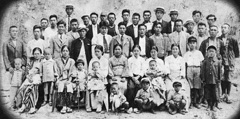| Special Invitation Films |
|---|
|
|
The Story of Koreans in Postwar Japan: Zainichi
(“Sengo zainichi gojunen shi: Zainichi”)- APAN / 1997 / Japanese / Color / 16mm / 258 min
 Director: Oh Deok-soo
Director: Oh Deok-soo
Photography: Honda Shigeru, Ishikura Ryuji, Shinoda Noboru
Sound: Honda Tsutomu, Tsuji Yoichiro
Music: Nozawa Mika, Minami Shigeko
Assistant Director: Kim Sung-woong
Narrator: Harada Yoshio
Producers: Kim Chang-kwan, Jinnouchi Naoyuki, Noguchi Kaori
Planning: Korean Junior Chamber of Commerce & Industry in Japan, End Fingerprint Cards! 1990 Committee, OH Kikaku
Production Committee, Source: The Story of Koreans in Postwar Japan: Zainichi Production Committee
Portraying the fifty-year history of zainichi Koreans after the liberation of Korea, traces of zainichi evoked in this film question the concepts of ‘post-war democracy’ and ‘pacifism’ in Japan. With copious stock footage and testimony, the first half of the film, “History,” chronologically traces the various experiences of zainichi from Japan’s defeat (Korean liberation) through 1990. The latter half, “People,” focuses on first, second and third-generation zainichi respectively, vividly depicting how they live. Many films about the zainichi, including one of Oh Deok-soo’s representative works, Against Fingerprinting (1984), will be screened as part of the special program BORDERS WITHIN—What It Means to Live in Japan.
[Director’s Statement] To live “zainichi” is to live “Japan”
In this country, there are people called “zainichi” whose roots are in the Korean Peninsula. They live across Japan, and it is said that they number one or two million. Of course, this figure does not represent citizenship. The number depends on how “zainichi” is defined. At any rate, the zainichi have a one-hundred year history, so if you try to include naturalized citizens, Koreans of mixed heritage, and others, it becomes rather difficult to come up with an accurate figure.
Everyone knows that there are zainichi in Japan, but not many know why, not even zainichi themselves. Many think that zainichi are simply the descendants of people who were “forcefully relocated.” It really is a shame. With this superficial knowledge, any understanding of why those young Korean kamikaze pilots flew their Zero fighter planes into enemy ships will remain out of reach.
Annexed in 1910, Korea was a colony of Japan until sixty years ago. In those days, people traveled by ferry back and forth across the Sea of Genkai, which lies between the Korean peninsula and the Japanese archipelago. Naturally, there was a lot of exchange, commerce and human drama. To gain a true understanding of this long history, it is necessary to look at each aspect in a multilayered and multifaceted way.
When Japan was defeated, there were over two million Koreans in Japan. Because the Japanese defeat meant Korean “liberation,” many Koreans returned to their mother country. Those who could not return due to internal or external circumstances remained in Japan, and came to be called “zainichi.”
Sixty years after the war, people fly across the strait. Times have changed. Yet, as the peninsula has gotten closer, the “mother country” has become increasingly remote with each successive generation of zainichi.
At the moment, zainichi are caught between the issue surrounding the abduction of Japanese by North Korea and the recent popularity of Korean entertainers. For zainichi, to live in Japan today is as difficult as ever.
 Oh Deok-soo
Oh Deok-soo
Born 1941 in Kazuno City, Akita Prefecture, Oh Deok-soo graduated from Waseda University in 1965. The following year he worked on The Daylight Demon as an assistant director and has since been involved in a number of Oshima Nagisa films in the same capacity. In 1968, he was hired by Toei Tokyo Studio and helped make TV films such as Key Hunter and Playgirl. In 1979, he left Toei and started up the production company OH Kikaku. His major works as a director include Now! Woman: It’s Time for Women to Change Society (1986), Masaaki’s Song (1988), and the fiction film, Our Age (2003), among others. |
